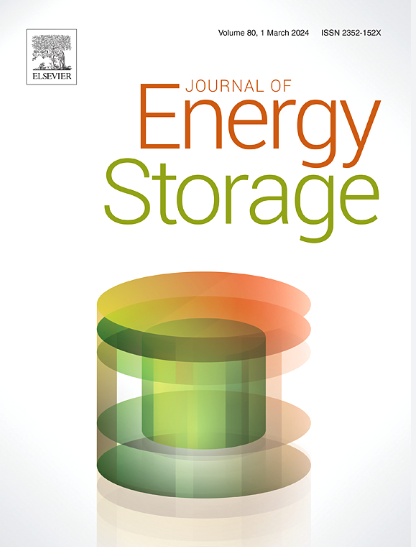磁场诱导表面活性剂修饰纳米fe3o4对相变冷库材料传热的调控
IF 8.9
2区 工程技术
Q1 ENERGY & FUELS
引用次数: 0
摘要
甲酸钠-氯化钾水基相变材料因其成本低、潜热高而被认为是有前景的冷储能材料。然而,高过冷性和低导热性阻碍了它们的实际应用。磁性金属纳米颗粒的加入可以有效地提高相变材料的导热性,减少相变材料的过冷性,但纳米颗粒的分散仍然存在问题。因此,本研究采用物理共混的方法,用表面活性剂CTAB对纳米fe3o4进行改性,提高其在相变材料中的分散性。制备的mpcm -1.2具有相变温度低(- 26.83℃)、潜热高(228.2 J/g)、过冷度低(1.27℃)等优点。经过50个热循环后,mpcm -1.2的熔化潜热仅下降了2.02%,表明其具有良好的循环稳定性。此外,随着交变磁场强度的增大,mpcm -1.2的凝固温度逐渐升高,而熔化温度逐渐降低。通过交变磁场感应ctab修饰的纳米fe3o4,实现了mpcm的可控相变换热。此外,MPCMs-1.2还能使鲫鱼在- 15°C以下冷藏17.53 h。该研究为水产短距离冷链运输提供了有效的解决方案。本文章由计算机程序翻译,如有差异,请以英文原文为准。

The heat transfer of phase change cold storage material regulated by magnetic field-induced surfactant-modified nano-Fe3O4
Sodium formate-potassium chloride water-based phase change materials are considered promising for cold energy storage due to their low cost and high latent heat. However, high supercooling and low thermal conductivity hinder their practical applications. The addition of magnetic metal nanoparticles can effectively enhance thermal conductivity and reduce supercooling of phase change materials, although nanoparticle dispersion remains problematic. Therefore, in this study, a physical blending method was used to modify nano-Fe3O4 with the surfactant CTAB, improving its dispersion in phase change materials. The prepared MPCMs-1.2 had the advantages of low phase transition temperature (−26.83 °C), high latent heat (228.2 J/g), and low supercooling (1.27 °C). After 50 thermal cycles, the latent heat of melting of MPCMs-1.2 decreased by only 2.02 %, indicating excellent cycle stability. Additionally, as the intensity of the alternating magnetic field increased, the solidification temperature of MPCMs-1.2 gradually increased, while the melting temperature decreased. The controllable phase transition heat transfer of MPCMs was achieved through the induction of CTAB-modified nano-Fe3O4 by the alternating magnetic field. Furthermore, MPCMs-1.2 was able to keep Carassius auratus refrigerated below −15 °C for 17.53 h. This study provides an effective solution for short-distance cold chain transportation of aquatic products.
求助全文
通过发布文献求助,成功后即可免费获取论文全文。
去求助
来源期刊

Journal of energy storage
Energy-Renewable Energy, Sustainability and the Environment
CiteScore
11.80
自引率
24.50%
发文量
2262
审稿时长
69 days
期刊介绍:
Journal of energy storage focusses on all aspects of energy storage, in particular systems integration, electric grid integration, modelling and analysis, novel energy storage technologies, sizing and management strategies, business models for operation of storage systems and energy storage developments worldwide.
 求助内容:
求助内容: 应助结果提醒方式:
应助结果提醒方式:


